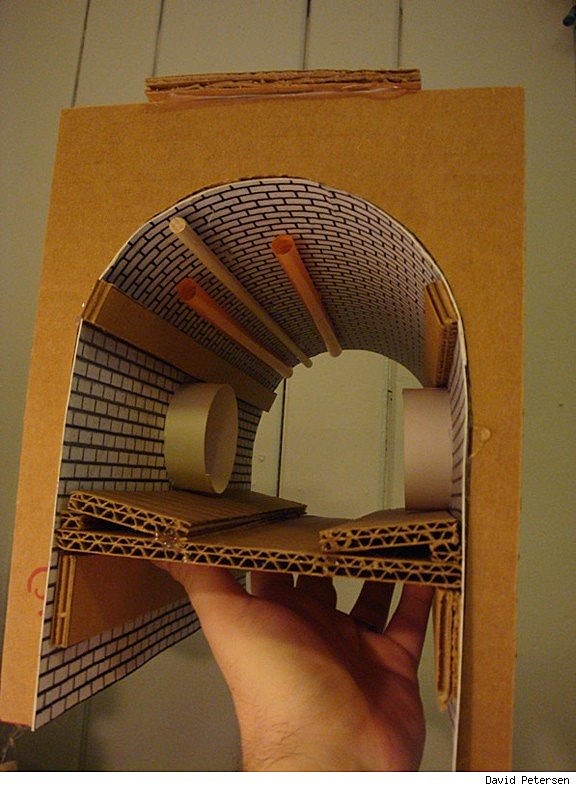
‘Mouse Guard’ Creator David Petersen Builds Models to Assist in Making Awesome TMNT Art

As readers of his Eisner award-winning Mouse Guard series know very well, David Petersen is no slouch when it comes to draftsmanship. The artist's work on Mouse Guard and really anything else he draws is characterized by incredibly lush and extremely precise line work. Petersen's backgrounds in particular seem as though they were designed as sets for film shoots rather than comic book panels. As it turns out, that's essentially what they are.
Faced with the daunting task of drawing a sewer tunnel for the cover of IDW's Teenage Mutant Ninja Turtles Micro-Series #2 one-shot, starring Donatello, Petersen put his pencil down and picked up an exacto knife to create a three-dimensional model upon which to base his drawing. Read more about the fascinating process after the cut.Petersen explained in a recent blog post that the Teenage Mutant Ninja Turtles inspired his lifelong interest in comics as well as role-playing games, making the IDW cover gig especially important to him. To convey the story of Donatello in a single image, Petersen set the character alone in a sewer tunnel so as to express Donny's "loney-loner vibe." But that came with a number of technical challenges, as Petersen explained:

After searching for good sewer photos, I wasn't able to come up with something I liked, so I just drew a sewer with a vaulted ceiling. I was worried about all the perspective for the concentric circles the arched roof was made of. I was also worried about getting the spacing of the bricks right.

I quickly mocked up a sewer model to match my sketch using printed out sheets of a brick pattern conformed to the shape of the arched cardboard. I added a few dowels and straws to simulate steam and or electrical pipes that can run along the roof of sewers and drain pipes.

I printed my rough drawing above with a photo of the model substituted for my rough background drawing. I inked the piece on my lightbox using my rough & photo as a guide for the ink lines. Like usual, when inking I'm concerned with texture and line quality...how different patterns of line can suggest different textures or surfaces.

The next step is to scan the inks and start 'flatting' which is the starting stage of coloring. Here I'm establishing areas of color..making the area that is Don's front shell different than the colors that are his arm or head or the sewer. Some color choices are made in this stage, but they could be all wrong on purpose if I wanted. The goal is to make sure that the different parts are all separated by a different color. Here I was pretty close and only made a few adjustments after I got into the rendering. I have to admit, even though I know the process, the flatness of these flats left me worried. I had envisioned a very atmospheric cover with a lot of depth and the flat colors showed that I had a long way to go to get there.

The last step was to render the piece. This means adding in all the shading and lighting effects and color holds and highlights. I was right when I thought it was going to be a long process from the flats to this point. There was a few hours of just tweaking the lighting and shadows until it was the right amount of contrast and glow.
TL;DR version: David Petersen is so for real that he will build a f***ing model of a sewer before turning in an imperfect drawing of a Ninja Turtle. And that's not all -- he does this kind of thing all the time. Check out this Facebook gallery of models Petersen made to help him illustrate Mouse Guard, and feel your appreciation of that excellent work grow even stronger.
Petersen's Michelangelo cover for Teenage Mutant Ninja Turtles Micro-Series #2 is on sale now in finer comics shops from IDW Publishing. Mouse Guard: The Black Axe #3 is on sale now from Archaia.
More From ComicsAlliance


![The Mad Hatter Sets His Sights (And His Hats) On New York City In ‘Batman/Teenage Mutant Ninja Turtles Adventures’ #5 [Preview]](http://townsquare.media/site/622/files/2017/03/BTMNT00.jpg?w=980&q=75)
![The Industry’s Best Artists Sketch The Heroes In A Half Shell For ‘Teenage Mutant Ninja Turtles: 100 Project’ [Preview]](http://townsquare.media/site/622/files/2017/03/TMNT_100Project_TPB-pr-11.png?w=980&q=75)

![Good Smile Keeps the Adorable Gaming Goodness Coming [Toy Fair 2017]](http://townsquare.media/site/622/files/2017/02/IMG_1960.jpg?w=980&q=75)

![NECA Pits Aliens Against Batman, Turtles Against Terminators And More [Toy Fair 2017]](http://townsquare.media/site/622/files/2017/02/IMG_2656.jpg?w=980&q=75)
![Ev-furry-body’s Got One: Nine Furry Comics Crushes [Love & Sex Week]](http://townsquare.media/site/622/files/2017/02/furry-feat.jpg?w=980&q=75)
